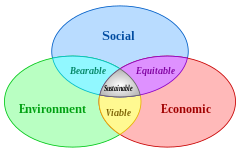 |
| A Venn Diagram that intersects social sustainability with environmental and economic sustainability. A situation can be viable, but if it is not bearable or equitable it cannot be sustainable. |
According to Social Life, a UK-based enterprise specializing in place-based innovation, social sustainability is "a process for creating sustainable, successful places that promote well-being, by understanding what people need from the places they live and work. Social sustainability combines design of the physical realm with design of the social world – infrastructure to support social and cultural life, social amenities, and systems for citizen engagement and space for people and places to evolve."
Social sustainability has many aspects to it, and you can read more about it at the United Nations Global Impact. Since our tips focus on small changes we can do today, I decided to focus on the one that might be the one the most immediately within our control. Namely, the idea that a workplace is not sustainable without employee retention; and workplaces lose money in production and staffing every year due to staff burnout; and it’s important with everything going on that we are sure to make our workplaces as socially sustainable as possible. I was in fact so happy to learn about this whole concept, because it rectifies the problems I have with the term "self care"-- while I was on board for awhile, "self care" has seemed to become this catch-all of workplace happiness and quite frankly, I've begun to think about it as a way that toxic workplaces can blame employees for their own low morale or other reactions to systemic workplace toxicity. This article helped to validate those feelings when I thought it was just me. I like viewing workplace culture through the social sustainability lens because it seeks to work on the workplace as well as the individual. It's about how we can make small changes to improve our workplace, not just about how we can steel ourselves against workplace toxicity as if it is an unexplained phenomenon that cannot be helped.
Stressful situations can flip your lid, and I know regular readers are familiar with this term but here is a video that explains it (it talks about kids, but we all need it!) Here are some things that have worked for me to stay engaged when it's tough:
 |
| Picture of a manatee with the following text: "What is done is done and cannot be undone. Learn from it and try again. And don't beat yourself up over it." |
-Walking also helps by working both sides of the brain to process short term memory into your long term memory, where feelings are not as attached. If you do not walk, or don’t have the time, tapping your sides or moving your eyes or limbs rhythmically for a few minutes (while listening to music, it that helps feel less odd) may help in a similar way (I apologize that I can't find a lot about this, but I learned it from a licensed therapist trained in EMDR, and all I know is that it really works for me).
-Leaving the area can give you a fresh perspective. Work on another task and come back to the frustration later. I know that I’ve had to decide to leave emails unanswered for hours sometimes. Unless it's marked high importance it can usually wait.
-Breathing deeply in and out with your tongue on the roof of your mouth, right in the middle, helps reconnect your brain, too and offers lots of relaxation benefits.
-Doing as many low level tasks as you can will help you stay productive, and you can start again tomorrow on big stuff (though, Reader, I must add that even if you are unable to be productive, you are still a valuable and worthy human being by the very nature of being alive). Removing yourself from the shame of ill productivity can actually help improve your morale and in turn improve your work flow, imagine that!
One of the things we can do to help un-flip our colleagues' and employees' lids is to “hold space” for them. As the linked article by Heather Plett states, this means that we are "willing to walk alongside another person in whatever journey they’re on without judging them, making them feel inadequate, trying to fix them, or trying to impact the outcome. When we hold space for other people, we open our hearts, offer unconditional support, and let go of judgement and control". We can “hold space” for our coworkers and employees so that they can “hold space” for the patrons, community, and other stakeholders we are serving, and the load of emotional labor we all bear is lightened.
If you’re interested in learning more about improving workplace culture, I have a Pinterest board full of resources about related issues.
What are some ways you make your workplace more socially sustainable? What would you need from your employer to feel more supported at work?

No comments:
Post a Comment